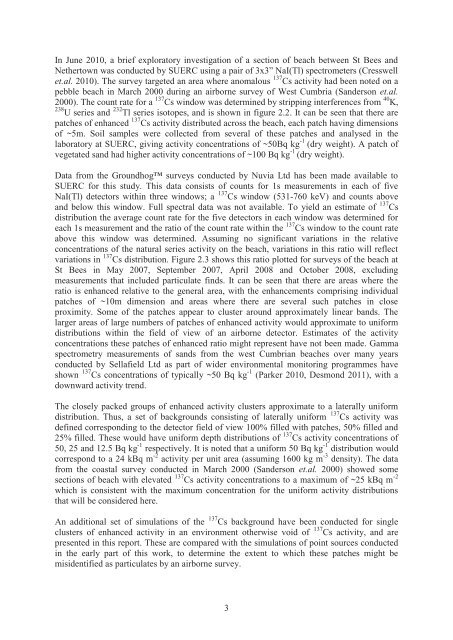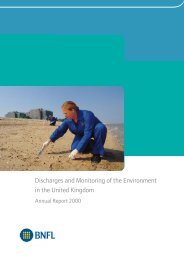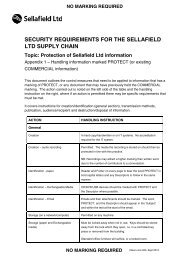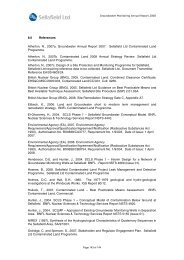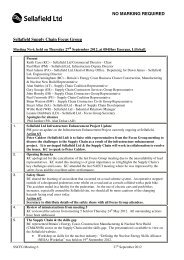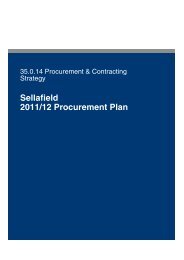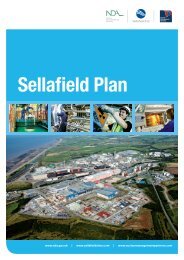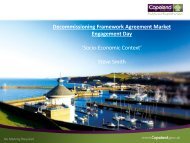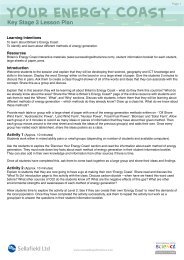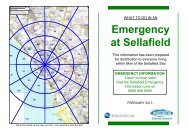Annual Report for 2010/11 and Forward Programme - Sellafield Ltd
Annual Report for 2010/11 and Forward Programme - Sellafield Ltd
Annual Report for 2010/11 and Forward Programme - Sellafield Ltd
You also want an ePaper? Increase the reach of your titles
YUMPU automatically turns print PDFs into web optimized ePapers that Google loves.
In June <strong>2010</strong>, a brief exploratory investigation of a section of beach between St Bees <strong>and</strong>Nethertown was conducted by SUERC using a pair of 3x3” NaI(Tl) spectrometers (Cresswellet.al. <strong>2010</strong>). The survey targeted an area where anomalous 137 Cs activity had been noted on apebble beach in March 2000 during an airborne survey of West Cumbria (S<strong>and</strong>erson et.al.2000). The count rate <strong>for</strong> a 137 Cs window was determined by stripping interferences from 40 K,238 U series <strong>and</strong> 232 Tl series isotopes, <strong>and</strong> is shown in figure 2.2. It can be seen that there arepatches of enhanced 137 Cs activity distributed across the beach, each patch having dimensionsof ~5m. Soil samples were collected from several of these patches <strong>and</strong> analysed in thelaboratory at SUERC, giving activity concentrations of ~50Bq kg -1 (dry weight). A patch ofvegetated s<strong>and</strong> had higher activity concentrations of ~100 Bq kg -1 (dry weight).Data from the Groundhog surveys conducted by Nuvia <strong>Ltd</strong> has been made available toSUERC <strong>for</strong> this study. This data consists of counts <strong>for</strong> 1s measurements in each of fiveNaI(Tl) detectors within three windows; a 137 Cs window (531-760 keV) <strong>and</strong> counts above<strong>and</strong> below this window. Full spectral data was not available. To yield an estimate of 137 Csdistribution the average count rate <strong>for</strong> the five detectors in each window was determined <strong>for</strong>each 1s measurement <strong>and</strong> the ratio of the count rate within the 137 Cs window to the count rateabove this window was determined. Assuming no significant variations in the relativeconcentrations of the natural series activity on the beach, variations in this ratio will reflectvariations in 137 Cs distribution. Figure 2.3 shows this ratio plotted <strong>for</strong> surveys of the beach atSt Bees in May 2007, September 2007, April 2008 <strong>and</strong> October 2008, excludingmeasurements that included particulate finds. It can be seen that there are areas where theratio is enhanced relative to the general area, with the enhancements comprising individualpatches of ~10m dimension <strong>and</strong> areas where there are several such patches in closeproximity. Some of the patches appear to cluster around approximately linear b<strong>and</strong>s. Thelarger areas of large numbers of patches of enhanced activity would approximate to uni<strong>for</strong>mdistributions within the field of view of an airborne detector. Estimates of the activityconcentrations these patches of enhanced ratio might represent have not been made. Gammaspectrometry measurements of s<strong>and</strong>s from the west Cumbrian beaches over many yearsconducted by <strong>Sellafield</strong> <strong>Ltd</strong> as part of wider environmental monitoring programmes haveshown 137 Cs concentrations of typically ~50 Bq kg -1 (Parker <strong>2010</strong>, Desmond 20<strong>11</strong>), with adownward activity trend.The closely packed groups of enhanced activity clusters approximate to a laterally uni<strong>for</strong>mdistribution. Thus, a set of backgrounds consisting of laterally uni<strong>for</strong>m 137 Cs activity wasdefined corresponding to the detector field of view 100% filled with patches, 50% filled <strong>and</strong>25% filled. These would have uni<strong>for</strong>m depth distributions of 137 Cs activity concentrations of50, 25 <strong>and</strong> 12.5 Bq kg -1 respectively. It is noted that a uni<strong>for</strong>m 50 Bq kg -1 distribution wouldcorrespond to a 24 kBq m -2 activity per unit area (assuming 1600 kg m -3 density). The datafrom the coastal survey conducted in March 2000 (S<strong>and</strong>erson et.al. 2000) showed somesections of beach with elevated 137 Cs activity concentrations to a maximum of ~25 kBq m -2which is consistent with the maximum concentration <strong>for</strong> the uni<strong>for</strong>m activity distributionsthat will be considered here.An additional set of simulations of the 137 Cs background have been conducted <strong>for</strong> singleclusters of enhanced activity in an environment otherwise void of 137 Cs activity, <strong>and</strong> arepresented in this report. These are compared with the simulations of point sources conductedin the early part of this work, to determine the extent to which these patches might bemisidentified as particulates by an airborne survey.3


